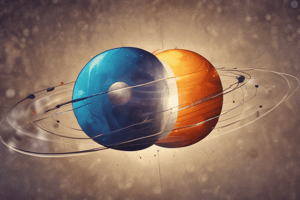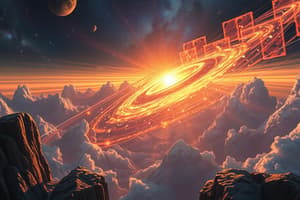Podcast
Questions and Answers
What phenomenon occurs as a charge accelerates, producing electromagnetic waves?
What phenomenon occurs as a charge accelerates, producing electromagnetic waves?
- It generates a static electric field without interaction.
- It solely releases ionizing radiation without a field interaction.
- It creates a magnetic field that interacts with an electric field. (correct)
- It causes the core of atoms to emit neutrons.
Which statement correctly describes the concept of isotopes?
Which statement correctly describes the concept of isotopes?
- Isotopes are versions of an element that differ in neutron count. (correct)
- Isotopes are elements that differ in their number of protons.
- Isotopes have the same number of neutrons but different numbers of protons.
- Isotopes possess identical properties regardless of neutron number.
What is defined as the process by which unstable atoms lose energy by emitting radiation?
What is defined as the process by which unstable atoms lose energy by emitting radiation?
- Photon absorption
- Decay
- Radioactivity (correct)
- Ionization
Which of the following statements about the speed of light is accurate?
Which of the following statements about the speed of light is accurate?
What does the double-slit experiment demonstrate about light?
What does the double-slit experiment demonstrate about light?
What happens to the force of gravity between two objects if the distance between them is doubled?
What happens to the force of gravity between two objects if the distance between them is doubled?
Which of the following statements about mass and weight is correct?
Which of the following statements about mass and weight is correct?
What is the fundamental property of matter that can be either positive or negative?
What is the fundamental property of matter that can be either positive or negative?
According to the conservation of energy principle, what happens to energy in a closed system?
According to the conservation of energy principle, what happens to energy in a closed system?
In the context of kinetic and potential energy, what occurs when an object is in free fall?
In the context of kinetic and potential energy, what occurs when an object is in free fall?
What describes the process by which a changing electric field induces a magnetic field?
What describes the process by which a changing electric field induces a magnetic field?
Which equation represents the force of gravity acting between two mass points?
Which equation represents the force of gravity acting between two mass points?
What does entropy measure in a system according to thermodynamics?
What does entropy measure in a system according to thermodynamics?
What is true about the relationship between electric charge and distance based on Coulomb's Law?
What is true about the relationship between electric charge and distance based on Coulomb's Law?
What best describes centripetal force?
What best describes centripetal force?
Flashcards are hidden until you start studying
Study Notes
Force and Motion
- Force is a push or pull on an object in a certain direction
- Mass is a measure of the amount of matter in an object, also a measure of inertia
- Acceleration is the rate of change of velocity with respect to time
- Newton's Law of Motion: Force equals mass times acceleration (F = ma)
Gravity
- Law of Universal Gravitation: Every point mass attracts every other point mass by a force acting along the line intersecting both points
- Inverse-Square Law: The force of gravity decreases with the square of the distance between two objects
- Gravitational Force Formula: F = G * (m1 * m2) / r^2
- F: force of gravity
- G: gravitational constant
- m1, m2: masses of the two objects
- r: distance between the two objects
Orbits and Centripetal Force
- Centripetal Force: a force that acts on an object moving in a circular path, directed towards the center of the circle
- Orbit: a path that an object follows as it revolves around a larger body, such as a planet or moon
Mass and Weight
- Mass is a measure of the amount of matter in an object
- Weight is the force of gravity acting on an object
- Your mass would be the same on Earth and on the Moon, but your weight would be different due to the different gravitational pulls.
Energy and Work
- Types of Energy
- Kinetic Energy: the energy of motion
- Potential Energy: stored energy due to an object's position or state
- Work and Energy
- Work: the transfer of energy from one object to another through a force applied over a distance
- Energy: the ability to do work
- Energy Conservation: Energy cannot be created or destroyed, only converted from one form to another.
Conservation of Energy
- The total energy of a closed system remains constant over time
Thermodynamics
- Temperature: a measure of the average kinetic energy of particles in a system
- Entropy: a measure of the disorder or randomness of a system
- Low Entropy: organized, structured system
- High Entropy: disordered, random system
- Second Law of Thermodynamics: the total entropy of a closed system always increases over time
Electromagnetism
- Electric Charge: a fundamental property of matter that can be positive or negative
- Electric Current: the flow of electric charge
Electric Fields
- Electric Field: a region around a charged particle or object where the force of the electric charge can be detected
- Coulomb's Law: the force between two electric charges is proportional to the product of the charges and inversely proportional to the square of the distance between them
- F: force between the charges
- k: Coulomb's constant
- q1, q2: electric charges
- r: distance between the charges
Maxwell's Equations
- A set of four equations that describe the behavior of electric and magnetic fields
- Equation 1: Electric field lines emerge from positive charges and enter negative charges
- Equation 2: Magnetic field lines form closed loops
- Equation 3: A changing electric field induces a magnetic field
- Equation 4: A changing magnetic field induces an electric field
Induction
- Induction: The process by which a changing magnetic field induces an electric field in a conductor
Electromagnetic Fields and Waves
- Electric and magnetic fields are two parts of the same bigger thing.
- When a charge is accelerated, it creates a magnetic field that interacts with the electric field, resulting in a chain reaction that makes the electromagnetic field radiate outwards into space as an electromagnetic wave.
The Structure of Atoms
- Atoms are made up of a core and electrons.
- The core (nucleus) is composed of protons and neutrons, which are made up of quarks.
- Particle Composition:
- Atom: Core (protons and neutrons) and electrons
- Core: Protons and neutrons
- Protons and Neutrons: Quarks
Elements and Isotopes
- Element: A substance that consists of atoms with the same number of protons in the core.
- Isotope: A version of an element with a different number of neutrons in the core.
- Depending on the number of protons in the core, you get different elements.
- Depending on the number of neutrons in the core, you get different isotopes of the same element.
Radioactivity
- Radioactivity: The process by which unstable atoms lose energy and stability by emitting ionizing radiation
- Most isotopes are unstable and will eventually fall apart, releasing ionizing radiation.
- The time it takes for half of the atoms to decay is called the half-life.
The Speed Of Light
- The speed of light is approximately 299,792,458 meters per second in a vacuum.
- This speed is constant and is a fundamental aspect of the universe.
Wave-Particle Duality
- Wave-Particle Duality: The property of particles, such as light, to exhibit both wave-like and particle-like behavior.
- Light can exhibit both wave-like and particle-like behavior, depending on how it is observed. This is demonstrated by the double-slit experiment.
Quantum Mechanics
- Quantum mechanics is the study of the behavior of matter at the atomic and subatomic levels.
- It is a fundamental theory of physics that explains the behavior of particles, atoms, and molecules.
- Key Principles of Quantum Mechanics:
- Quantization: Energy and other physical quantities are not continuous but occur in discrete, quantized values.
- Wave-Particle Duality: Particles exhibit both wave-like and particle-like behavior.
- Uncertainty Principle: It is impossible to know both the exact position and momentum of a particle simultaneously.
- Superposition: Particles can exist in multiple states simultaneously until measured.
- Entanglement: Two or more particles can be linked in a way that allows them to share a common fate even when separated.
- Quantum mechanics has had a profound impact on our understanding of the universe and has led to the development of many technologies, such as lasers and transistors.
Studying That Suits You
Use AI to generate personalized quizzes and flashcards to suit your learning preferences.




